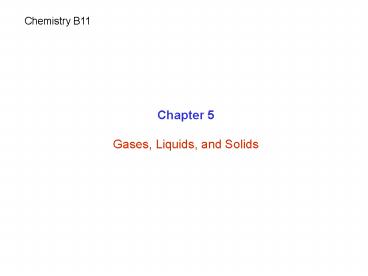Gases, Liquids, and Solids - PowerPoint PPT Presentation
1 / 31
Title:
Gases, Liquids, and Solids
Description:
Chemistry B11 Chapter 5 Gases, Liquids, and Solids Gases T move faster Kinetic energy Gases Attractive forces Kinetic energy Keeps molecules apart Brings ... – PowerPoint PPT presentation
Number of Views:215
Avg rating:3.0/5.0
Title: Gases, Liquids, and Solids
1
Chemistry B11
Chapter 5 Gases, Liquids, and Solids
2
Gases
move faster Kinetic energy ?
T ?
3
Gases
Physical state of matter depends on
Attractive forces
Kinetic energy
Keeps molecules apart
Brings molecules together
4
Gases
Gas
High kinetic energy (move fast)
Low attractive forces
Liquid
Medium kinetic energy (move slow)
medium attractive forces
Solid
Low kinetic energy (move slower)
High attractive forces
5
Physical Changes
Melting
Boiling
Change of states
6
Ideal Gases
Kinetic molecular theory
- Particles move in straight lines, randomly.
- Kinetic energy of particles depends on
temperature. - Particles collide and change direction (they may
exchange - kinetic energies).
- Gas particles have no volume.
- No attractive forces between gas particles.
- More collision greater pressure.
In reality, There is no ideal gas (all gases are
real).
At STP (Standard Temperature and Pressure) we
can consider them as ideal.
T 0C (273 K) P 1 atm
7
Pressure (P)
F constant
A constant
P ?
P ?
A ?
F ?
Atmosphere (atm) Millimeters of mercury (mm
Hg) torr in. Hg Pascal
1 atm 760 mm Hg 760 torr
101,325 pascals 29.92 in. Hg
8
Pressure (P)
barometer atmospheric pressure
manometer pressure of gas in a container
9
Gases
m,T constant
Boyles law
P 1/a V
PV a constant
P1V1 P2V2
P1V1
P1V1
P2
V2
V2
P2
10
Gases
Boyles law
11
Gases
m,P constant
Charless law
V
T a V
a constant
T
V1
V2
T2
T1
V1T2
T1V2
V2
T2
T1
V1
12
Gases
Charless law
13
Gases
m,V constant
Gay-Lussacs law
P
P a T
a constant
T
P1
P2
T2
T1
P1T2
T1P2
P2
T2
T1
P1
14
Gases
Gay-Lussacs law
15
Gases
combined gas law
P2V2
P1V1
PV
a constant
T
T2
T1
Avogadros law
T1
P1
P1 P2
V1
n1 n2 n number of molecules
V1 V2
T2
P2
T1 T2
V2
16
Gases
Ideal gas law
n number of moles (mol) R universal gas
constant V volume (L) P pressure (atm) T
temperature (K)
PV nRT
17
Gases
Daltons law of partial pressures
PT P1 P2 P3
18
Intermolecular Forces
London dispersion forces
Intermolecular Forces
lt
Dipole-dipole interaction
Ionic bonds Covalent bonds
Intramolecular (Bonding) Forces
Hydrogen bonding
19
London dispersion forces
Attractive forces between all molecules
Only forces between nonpolar covalent molecules
He
He
He
He
d-
d
_
_
_
_
_
_
_
2
2
_
2
2
Original Temporary Dipole
No Polarity
He
He
d-
d
d-
d
_
_
2
_
2
_
Original Temporary Dipole
Induced Temporary Dipole
20
London dispersion forces
He T -240C (1 atm) ? liquid
Kinetic energy ? Move slower
Attractive forces become more important
T ?
liquid
21
Dipole-Dipole Interactions
Attractive forces between two polar molecules
22
Hydrogen bonding
Between H bonded to O, N, or F (high
electronegativity) ? d and a nearby O, N, or F ?
d-
H2O
Stronger than dipole-dipole interactions London
dispersion forces
23
Hydrogen bonding
d
CH3COOH Acetic acid
d-
24
H-bonding in our body
Protein (a-helix)
25
Evaporation
equilibrium
Vapor pressure the pressure of a gas in
equilibrium with its liquid form in a closed
container.
Boiling point the temperature at which the vapor
pressure of a liquid is equal to the atmospheric
pressure.
26
Evaporation
normal boiling point the temperature at which a
liquid boils under a pressure of 1 atm.
1 atm.
760 mm Hg
Diethyl ether
CH3OH
H2O
27
Boiling point
Factors that affect boiling point
1. Intermolecular forces London dispersion
forces lt Dipole-Dipole interactions lt Hydrogen
bonds
28
Solids
Network solids (network crystals)
Amorphous solids
29
Solids
Solidification (Crystallization) change phase
from liquid to solid.
Fusion (melting) change phase from solid to
liquid.
Sublimation change phase from solid directly
into the vapor.
30
Heating Curve
during the phase changes, the temperature stays
constant.
31
Phase diagram































